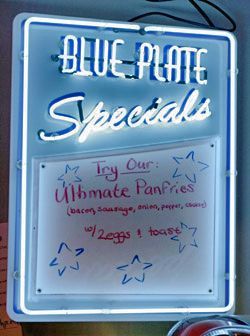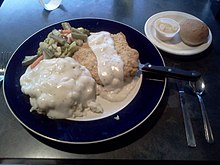Blue-plate special
[2] Alternatively, Kevin Reed says that "during the Depression, a manufacturer started making plates with separate sections for each part of a meal — like a TV dinner tray — it seems that for whatever reason they were only available in the color blue.
A May 27, 1926 advertisement in The New York Times for "The Famous Old Sea Grill Lobster and Chop House" at 141 West 45th Street promised "A La Carte All Hours", "Moderate Prices", and "Blue Plate Specials".
[3] A Hollywood columnist wrote in 1940, "Every time Spencer Tracy enters the Metro commissary, executives and minor geniuses look up from their blue plate specials to look at the actor and marvel.
In the 1974 film The Front Page, condemned killer Earl Williams is said to be getting a "95-cent blue plate special from the greasy spoon across the street" for his last meal.
In The Devil All The Time[7] (Netflix), Willard is offered the meatloaf "blue plate special" by the waitress in the Wooden Spoon Diner in Meade, Ohio; he opts instead for coffee and a doughnut.
In Graham Greene's Our Man in Havana (first published in 1958), the protagonist, Mr Wormold, is almost poisoned by a rival while eating a blue-plate lunch at a meeting of the European Traders' Association.
[9] Richard Bernstein titled his New York Times review of Andrew Hurley's book Diners, Bowling Alleys, and Trailer Parks (2001),[10] "The Red, White and Blue Plate Special".


